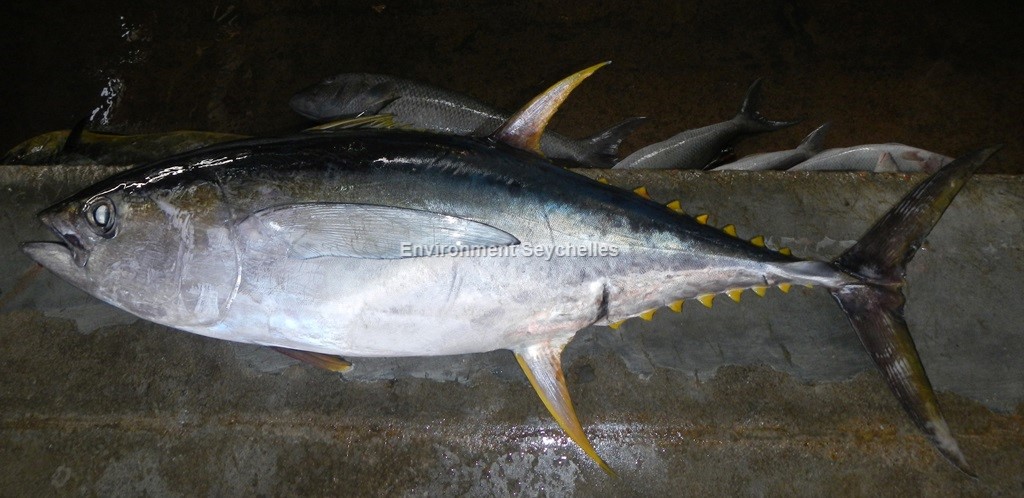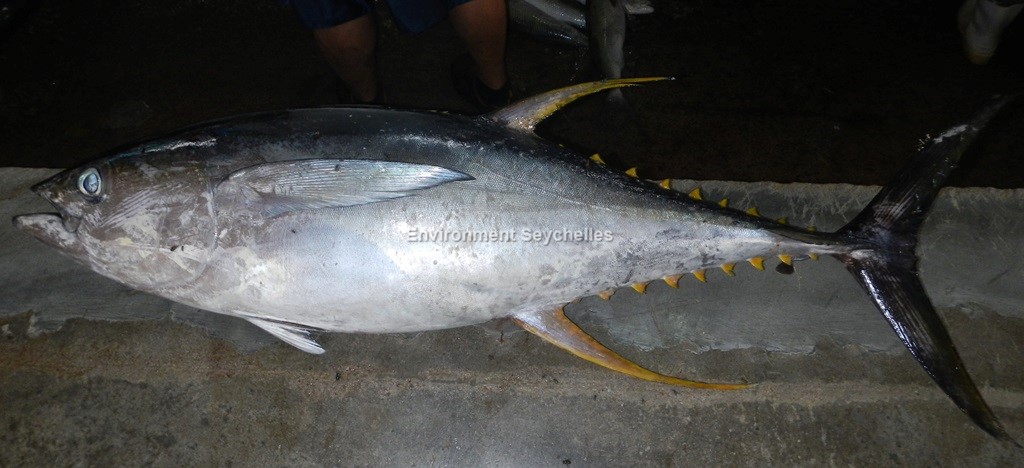Description:
Dorsal spines: 11-14; Dorsal rays: 12-16; Anal spines: 0; Anal soft rays: 11-16.
Large species with elongate, fusiform body, slightly compressed laterally. Some large specimens have very long second dorsal and anal fins. Dorsal fins separated by narrow gap. The second dorsal followed by 8-10 finlets. Anal fin followed by 7-10 finlets. Pectoral fins moderately long, usually reaching beyond second dorsal fin origin but not beyond end of its base. In juveniles pectoral fin tip rounded. Caudal peduncle very slender with a strong lateral keel between 2 smaller keels. Caudal fin with central marginal notch.
Colour. Metallic dark blue dorsally changing though yellow to silver ventrally. Ventral surface and flanks often with approximately 20 broken, near vertical pale lines. Dorsal and anal fins and finlets bright yellow. Finlets with narrow black border.
Size:
Maturity: Lm 103.3cm FL, range 78 - 158 cm FL. Max Length: 239cm FL. Commonly to 150cm TL.
There is considerable regional variation in maturity size, authors appear to agree however that all fish over 120 cm TL have attained sexual maturity.
Habitat and Ecology:
An oceanic species, occasionally seen near reefs (depth 1-250m, usually 1-100m). Forms mono-specific or multispecies schools usually by size. Also associated with floating debris. Feeds on fishes, crustaceans and squids. Eggs and larvae are pelagic. In the Indian Ocean, longevity is at least seven years, although very few individuals live past four years.
Fishery Status:
This species is not protected or subject to fishery regulations in the artisanal fishery. It is caught the hand line fishery, where it is a reasonably regular but generally not abundant component of the catch.
Catch limits have recently been by the IOTC on the industrial catch of this species where it is caught mainly with longlines and purse seines.
Notes:
References:
Collette, B.B. & Nauen, C.E. (1983). FAO Species catalogue. Vol. 2 Scombrids of the World. An Annotated and Illustrated catalogue of Tunas, Mackerels, Bonitos and Related Species Known to Date. FAO 1983. ISBN 92-5-101381-0
Collette, B. et al 2011. Thunnus albacares. The IUCN Red List 2011: e.T21857A9327139. http://dx.doi.org/10.2305/IUCN.UK.2011-2.RLTS.T21857A9327139.en. (02/06/19).
Froese, R. & D. Pauly. Eds. 2019. FishBase. https://www.fishbase.in/summary/143 (02/06/19).
Citation:



Enjoyed every bit of your blog.Really looking forward to read more. Will read on…
I’ll right away grab your rss feed as I can’t find your email subscription hyperlink or e-newsletter service.
Do you have any? Kindly let me recognize so that I could subscribe.
Thanks. https://tonybetcanada.Wordpress.com/
Im grateful for the article post. Want more.
Appreciate you sharing, great post.Really looking forward to read more. Want more.
Looking forward to reading more. Great blog post.Really thank you! Fantastic.
I think this is a real great post.Really thank you! Great.
Awesome blog post.Thanks Again. Really Great.
Looking forward to reading more. Great blog post.Really looking forward to read more. Much obliged.
I cannot thank you enough for the post. Keep writing.
I cannot thank you enough for the blog article.Thanks Again. Awesome.
Major thankies for the article post. Want more.
Im grateful for the post.Really thank you! Really Cool.
Great, thanks for sharing this blog.Really thank you! Want more.
Thanks for sharing, this is a fantastic blog post.Really looking forward to read more. Want more.
Lovely just what I was searching for.
Thank you ever so for you blog article.Much thanks again.
Wow, great blog article.Thanks Again. Awesome.
Thanks for the post.Thanks Again. Cool.
Awesome post.Thanks Again. Really Great.
Thanks for sharing, this is a fantastic article.Really thank you! Cool.
Great, thanks for sharing this blog.Really looking forward to read more. Really Great.
Im obliged for the post.Much thanks again. Really Great.
I appreciate you sharing this blog post.Really thank you! Really Cool.
Thank you ever so for you blog.Thanks Again. Really Cool.
Enjoyed every bit of your blog article.Much thanks again. Great.
Thanks for the blog post. Fantastic.
I appreciate you sharing this blog post.Thanks Again. Really Cool.
Major thanks for the blog post.Really thank you! Keep writing.
Major thanks for the blog post.Thanks Again. Keep writing.
Muchos Gracias for your blog.Really thank you! Fantastic.